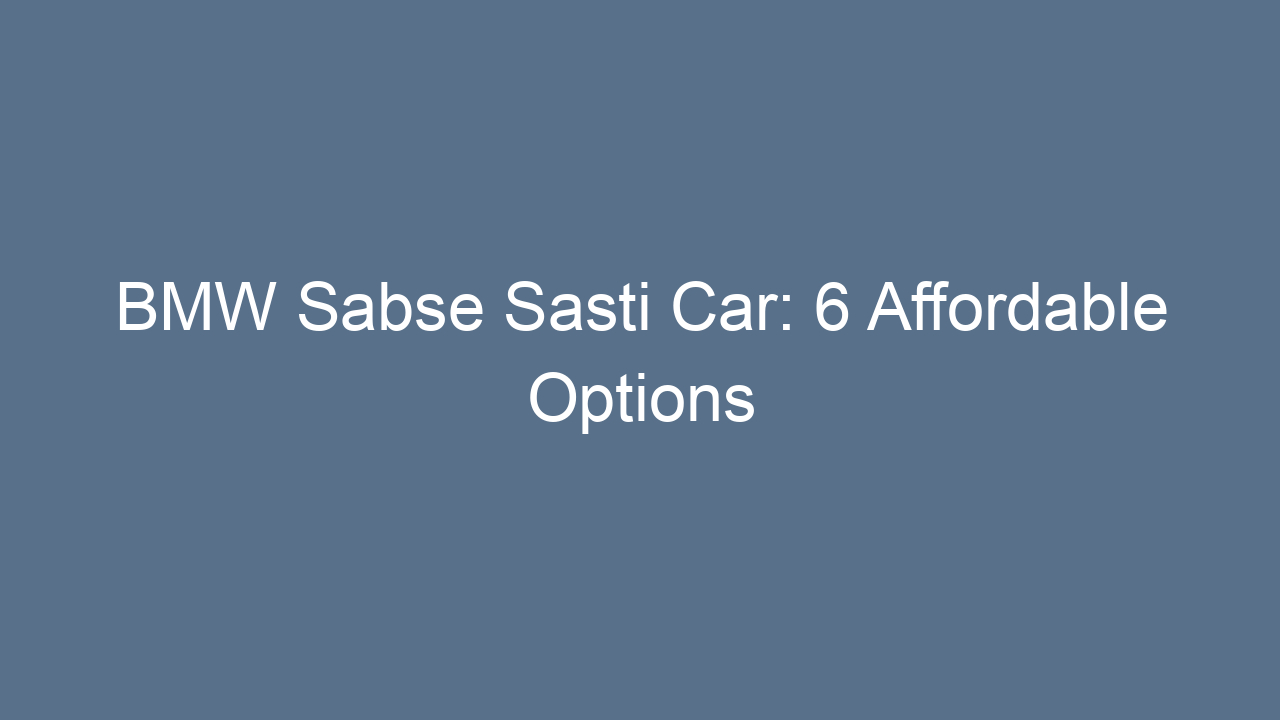BMW Sabse Sasti Car: 6 Affordable Options

Looking for a BMW sabse sasti car? Discover six surprisingly affordable BMW models that blend luxury with value, proving a premium driving experience is within reach.
In This Article
- 1 Key Takeaways
- 2 Understanding “Sabse Sasti Car” in the BMW Context
- 3 6 Affordable BMW Options You Must Check
- 4 The Value of Certified Pre-Owned (CPO) BMWs
- 5 Factors Affecting the “Sabse Sasti Car” Price
- 6 Pro Tip:
- 7 Considering Maintenance Costs for Affordable BMWs
- 8 FAQ: Your Affordable BMW Questions Answered
- 8.1 Q1: What is the absolute cheapest new BMW I can buy?
- 8.2 Q2: Are older BMWs really that expensive to maintain?
- 8.3 Q3: Which BMW models are known for better reliability?
- 8.4 Q4: Is it better to buy a used BMW from a dealer or a private seller?
- 8.5 Q5: How much should I budget for annual maintenance on an older BMW?
- 8.6 Q6: Can I find a used BMW coupe that is affordable?
- 9 Conclusion
Key Takeaways
- Find budget-friendly BMW models.
- Explore certified pre-owned BMW options.
- Understand the value of older BMW generations.
- Compare running costs for affordable BMWs.
- Learn where to find great deals on used BMWs.
- Consider BMW models known for reliability.
Dreaming of owning a BMW but worried about the price tag? You’re not alone! Many people think BMWs are out of reach for average budgets. But what if we told you that you could experience German engineering and luxury without breaking the bank? Identifying the BMW sabse sasti car, or the cheapest BMW car, involves looking beyond just the new models. It means exploring the used car market, understanding different trim levels, and knowing which models hold their value while offering a great driving experience. This guide is designed to simplify that search for you. We’ll break down six of the most affordable BMW options available, making that luxury car dream a tangible reality. Get ready to discover your next premium ride at a surprisingly accessible price point.
Understanding “Sabse Sasti Car” in the BMW Context
When we talk about “BMW sabse sasti car,” we’re not typically referring to brand-new entry-level models, although BMW does have those. Instead, the most accessible way to own a BMW for many people is by exploring the pre-owned market. The perception that BMWs are exclusively for the ultra-wealthy often overlooks the fact that these cars are built with durability and longevity in mind. A well-maintained older BMW can offer a significantly more premium experience than a brand-new car from a less prestigious brand. The key is to research models known for their reliability, understand typical maintenance costs, and look for certified pre-owned (CPO) vehicles that come with inspections and warranties. This approach allows you to tap into BMW’s legacy of performance and luxury at a fraction of the original cost, truly making it the “cheapest BMW car” in terms of the value you receive per dollar spent.
6 Affordable BMW Options You Must Check
Finding a BMW that fits your budget is entirely possible. By focusing on models that have been on the market for a few years or are known for their robust engineering, you can find excellent value. These vehicles still offer that signature BMW driving feel, quality interior, and advanced technology, often at prices comparable to new cars from mainstream brands. Let’s dive into six specific BMW models that are often cited as the most affordable choices for discerning drivers.
1. BMW 3 Series (Older Generations)
The BMW 3 Series is often considered the quintessential BMW. It’s renowned for its perfect balance of sportiness, comfort, and practicality. While newer models can be expensive, older generations, particularly those from the E90 (2006-2013) and F30 (2012-2019) eras, offer exceptional value on the used market. These cars are plentiful, meaning you have a wide selection to choose from. They still feature sophisticated engineering, engaging handling, and desirable luxury appointments. Look for well-maintained examples, and you’ll find a car that drives like a dream without the premium new car price. The 328i and 330i trims, in particular, offer a great blend of performance and efficiency.
Why Older 3 Series is a Great Choice
- Proven Reliability: Many older 3 Series models have stood the test of time.
- Driving Dynamics: Still offers one of the best driving experiences in its class.
- Parts Availability: Common model means parts are readily available and often more affordable.
- Luxury Interior: Even older models boast high-quality materials and design.
When looking at older 3 Series models, it’s crucial to get a pre-purchase inspection from a BMW specialist. This can help identify any potential issues that might have arisen with age and mileage. Services like those offered by BMW USA can provide insights into model features and options that might help you narrow down your search.
2. BMW 1 Series (128i, 135i)
The BMW 1 Series is the brand’s compact executive car, offering a more accessible entry point into BMW ownership. While a bit smaller than the 3 Series, it doesn’t compromise on the core BMW driving experience. Models like the 128i and the sportier 135i (particularly the E82 coupe and E88 convertible) offer agile handling and peppy performance. These cars are often more affordable than their 3 Series counterparts, making them an excellent option for budget-conscious buyers who still crave that BMW pedigree. The rear-wheel-drive platform provides the classic BMW feel that enthusiasts love.
Pros and Cons of the BMW 1 Series
| Pros | Cons |
|---|---|
| Compact and agile handling | Smaller interior space than 3 Series |
| More affordable entry price | Potentially higher maintenance on performance variants (135i) |
| Excellent fuel economy in 128i | Rear seats can be tight for adults |
The 1 Series is a fantastic choice if you prioritize driving engagement and are looking for a smaller, more maneuverable BMW. Websites like Edmunds offer extensive reviews and pricing data for used 1 Series models, which can be invaluable in your research.
3. BMW X1 (First Generation)
For those who need a bit more versatility and a higher driving position, the first-generation BMW X1 (E84, 2009-2015) presents a compelling case. It was BMW’s first foray into the compact luxury SUV segment, and it brought BMW’s characteristic driving dynamics to the crossover market. Available in both rear-wheel drive and xDrive all-wheel drive, the X1 offers a good balance of practicality, fuel efficiency (especially with the 4-cylinder engines), and that undeniable BMW premium feel. You can often find these models at prices that make them one of the most accessible SUVs from a luxury brand.
Key Features of the First-Gen X1
- Versatile Cargo Space: Practical for daily errands and weekend trips.
- Comfortable Ride: Offers a good balance between sportiness and comfort.
- Available AWD: xDrive provides added confidence in various weather conditions.
- Premium Interior: A well-appointed cabin typical of BMW standards.
The X1 is ideal for individuals or small families looking for a premium compact crossover without the hefty price tag. Researching common issues for the specific model year you’re considering is always a good practice. Resources like CarComplaints.com can highlight potential problems to watch out for.
4. BMW 5 Series (Older Generations, E60, F10)
The BMW 5 Series represents a step up in size and luxury from the 3 Series, offering a more refined and comfortable experience, especially for longer journeys. While newer 5 Series models are definitely on the higher end of the price spectrum, older generations like the E60 (2003-2010) and F10 (2010-2017) can be found at surprisingly attractive prices on the used market. These cars offer a substantial presence, powerful engines, and an interior packed with advanced features for their time. Choosing a non-M sport variant and a less complex engine (like the 528i or 535i) can further reduce purchase price and potential maintenance costs.
Why Consider an Older 5 Series?
- Executive Comfort: Plush ride and spacious interior for long drives.
- Smooth Power: Refined engines deliver effortless acceleration.
- Advanced Technology: Many features were ahead of their time and still feel modern.
- Prestige: Offers a significant level of luxury and status within budget.
When looking at older 5 Series sedans, pay close attention to the maintenance history. These cars have more complex systems, so regular servicing is crucial for longevity. Don’t overlook dealership service records or independent BMW specialist reports. For understanding vehicle history, services like Carfax are invaluable.
5. BMW Z4 (Older E85/E86, E89 Generations)
For the driving enthusiast who dreams of a two-seat roadster, the BMW Z4 offers an attainable path. Older generations, like the E85/E86 (2002-2008) and the E89 (2009-2016), provide the thrilling open-top driving experience that BMW is famous for, often at a fraction of the cost of a new sports car. The Z4 delivers sharp handling, powerful engines (especially in the 6-cylinder variants), and classic BMW styling. While practicality isn’t its strong suit, the sheer joy of driving a well-engineered roadster makes it a compelling choice for a second car or a weekend cruiser.
Z4: A Fun and Affordable Option
| Model | Years | Engine Options | Key Appeal |
|---|---|---|---|
| Z4 (E85/E86) | 2002-2008 | 2.5L, 3.0L Inline-6 | Classic roadster feel, sharp handling |
| Z4 (E89) | 2009-2016 | 2.5L, 3.0L, 3.0L Turbo Inline-6 | Retractable hardtop, modern features |
When buying a Z4, check the condition of the convertible top mechanism (if applicable) and ensure all electronics are functioning correctly. These are enthusiast cars, so look for examples that have been driven and maintained by people who appreciate them. Websites like Bring a Trailer can give you a good sense of the market value and what to look for in well-maintained examples.
6. BMW X3 (First Generation, E83)
Similar to the X1, the first-generation BMW X3 (E83, 2003-2010) offers a more compact and budget-friendly take on the luxury SUV. While it might not have the same refined interior as later generations, it delivers a robust and capable driving experience, especially with the xDrive all-wheel-drive system. The X3 provides excellent practicality for families or anyone needing more cargo space and a higher seating position. It’s a great way to get into a BMW SUV without the premium price of newer models. Look for models with well-documented maintenance history, as these are capable vehicles that can handle many miles with proper care.
Advantages of the First-Gen X3
- Practicality: Offers good cargo space and passenger room for its size.
- All-Weather Capability: xDrive system provides confident traction.
- BMW Driving Feel: Retains a degree of sportiness absent in many competitors.
- Affordable Luxury SUV: A budget-friendly entry into the premium SUV segment.
The E83 X3 is a solid choice for those needing a dependable, premium-feeling SUV. A thorough inspection is recommended, focusing on the drivetrain and suspension components. For information on recalls and technical service bulletins, the National Highway Traffic Safety Administration (NHTSA) website is a valuable resource.
The Value of Certified Pre-Owned (CPO) BMWs
When searching for your affordable BMW, the Certified Pre-Owned (CPO) program offered by BMW is a fantastic option to consider. A CPO BMW is a pre-owned vehicle that has undergone rigorous inspection by factory-trained technicians, met specific mileage and condition requirements, and is reconditioned to BMW’s exacting standards. These vehicles typically come with an extended warranty, roadside assistance, and a detailed vehicle history report. While CPO vehicles might be slightly more expensive than non-certified used cars, the peace of mind that comes with a thorough inspection and extended warranty can be well worth the investment, especially for complex luxury vehicles like BMWs.
Benefits of a CPO BMW
- Rigorous Inspection: Ensures the vehicle is in excellent mechanical and cosmetic condition.
- Extended Warranty: Provides coverage beyond the original manufacturer’s warranty.
- Roadside Assistance: Offers support for unexpected issues.
- Vehicle History Report: Transparency regarding the car’s past.
- Reconditioned to Standards: Ensures a high level of quality and reliability.
Purchasing a CPO BMW can significantly reduce the risk associated with buying a used luxury car, making it a smart strategy for finding your “BMW sabse sasti car” with added confidence.
Factors Affecting the “Sabse Sasti Car” Price
When you’re on the hunt for the cheapest BMW car, several factors will influence the final price. Understanding these can help you make a more informed decision and potentially find an even better deal. The model and year are obvious starting points, but don’t forget about mileage, condition, trim level, and whether it’s a private sale or from a dealership.
Key Price Influencers:
- Mileage: Higher mileage generally means a lower price, but also potentially more wear and tear.
- Condition: A car in pristine condition with a full service history will command a higher price than one with cosmetic flaws or deferred maintenance.
- Trim Level & Options: Higher trim levels (e.g., fully loaded models with premium packages) will be more expensive than base models.
- Engine Choice: More powerful or desirable engines (like a V8 over a 4-cylinder) often increase the price.
- Location: Prices can vary based on regional demand and supply.
- Seller Type: Dealerships generally price cars higher than private sellers due to overhead and reconditioning costs.
By being aware of these factors, you can better assess if a particular car is a good value and negotiate effectively. For instance, a slightly higher mileage car in excellent condition with a proven maintenance record might be a better long-term buy than a lower mileage car with a spotty history.
Pro Tip:
Always factor in potential maintenance costs when calculating the true “cheapest” BMW car for you. A slightly more expensive but well-maintained model with a solid service history might save you money in the long run compared to a “bargain” car that needs immediate repairs.
Considering Maintenance Costs for Affordable BMWs
One of the most significant considerations when buying an affordable BMW is understanding and budgeting for maintenance and repair costs. While the purchase price might be low, BMWs are premium vehicles, and their parts and labor can be more expensive than those for mainstream brands. However, by choosing models known for reliability and opting for preventative maintenance, you can manage these costs effectively.
Tips for Managing BMW Maintenance Costs:
- Choose Reliable Models: As highlighted, certain models and engine variants are known for fewer common issues.
- Regular Preventative Maintenance: Following the recommended service schedule is crucial.
- Find a Reputable Independent Mechanic: Specializing in BMWs, they can often offer more competitive pricing than dealerships.
- Join BMW Forums: These communities offer invaluable advice on common issues and DIY fixes.
- Buy Quality Parts: While OEM parts are best, reputable aftermarket brands can offer good value.
For example, if you’re looking at a 3 Series, understand that the 328i (N52 engine) is generally considered more robust and less prone to costly issues than some turbocharged variants of previous generations. Researching common problems for the specific model and year you’re interested in is key. Resources like the BMW Service section on their official website can provide general maintenance information.
FAQ: Your Affordable BMW Questions Answered
Q1: What is the absolute cheapest new BMW I can buy?
The cheapest new BMW is typically the 2 Series Gran Coupe or the X1 sDrive28i, depending on current manufacturer incentives and options. However, “cheapest” for a new BMW still represents a significant investment.
Q2: Are older BMWs really that expensive to maintain?
They can be, but it depends on the model and condition. Well-maintained older BMWs, especially simpler models, can be reasonably affordable to maintain. Unexpected repairs are the main cost driver, so a pre-purchase inspection is vital.
Q3: Which BMW models are known for better reliability?
Generally, models like the BMW 3 Series (especially with the N52 engine found in certain 328i models) and the BMW X1 (first generation) are considered fairly reliable when properly maintained. Simpler, naturally aspirated engines often have fewer potential issues than complex turbocharged or diesel powerplants.
Q4: Is it better to buy a used BMW from a dealer or a private seller?
Buying from a dealership, especially a BMW certified pre-owned program, offers more buyer protection, warranties, and inspections. Private sellers might offer lower prices but come with more risk, requiring thorough due diligence and inspections.
Q5: How much should I budget for annual maintenance on an older BMW?
This varies greatly, but it’s wise to budget at least $1,000-$2,000 per year for routine maintenance (oil changes, filters, brakes, tires) and an additional buffer for unexpected repairs on older vehicles.
Q6: Can I find a used BMW coupe that is affordable?
Yes, models like the older 1 Series coupes (E82) or 2 Series coupes (F22) can be found at increasingly attractive prices on the used market, offering sporty styling and performance at a lower cost.
Conclusion
Owning a BMW doesn’t have to be an unattainable dream. By exploring the robust used car market and focusing on models known for their enduring quality and driving pleasure, you can find a BMW sabse sasti car that fits your budget and lifestyle. From the versatile X1 and X3 SUVs to the iconic 3 Series and the sporty Z4, there are several excellent options waiting to be discovered. Remember, the true value lies not just in the initial purchase price, but in the enduring quality, performance, and luxury that a BMW provides. With careful research, a thorough inspection, and a realistic budget for maintenance, you can confidently experience the thrill of driving a BMW without breaking the bank.






